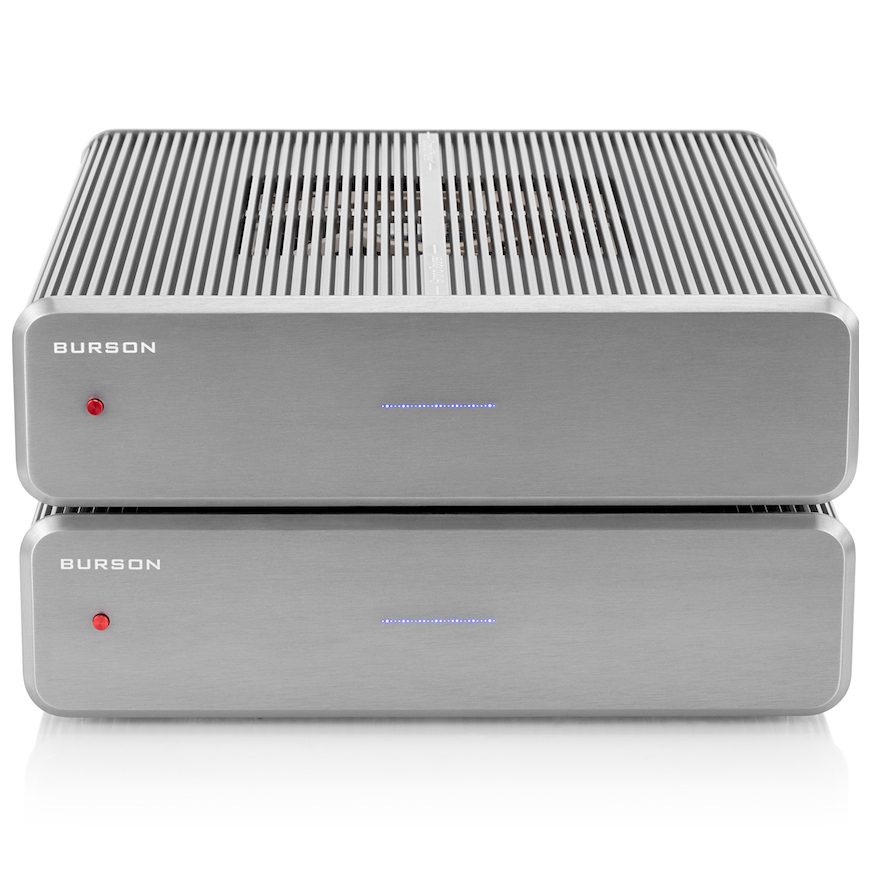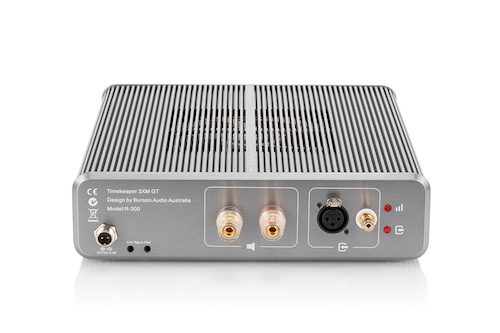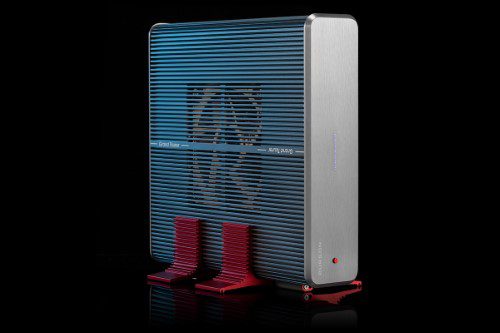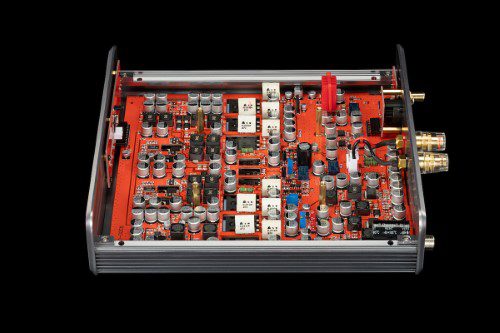
Burson Audio’s new Timekeeper 3X GT monoblock amplifier – two make a stereo pair – gives 30 Class-A Watts per channel into four and eight Ohms with a further 150 in Class-AB for a maxed-out 180 Watts. The Timekeeper copes with speaker loads as low as two Ohms, but never mind. None of that is particularly notable.
What might make the Timekeeper worthy of attention is that it offers Class-A sonics in such a comparatively small and light weight package. We are talking chunky paper‑back book and a bag and a half of sugar per channel here. In other words Class-A power amplification in the kind of form-factor that we might associate more with Class-D.

Burson Audio has achieved this by using a proprietary switch-mode power supply and forced cooling. Other manufacturers, whose amplifiers we might regard performance-wise as alternatives to the Timekeeper, remain wedded to what Burson calls old-school engineering; linear power supplies that use large capacitors and weighty toroidal transformers, inside necessarily much larger boxes adorned with cooling fins. Just whether and by how much size and weight really matters in the home audio context is a moot point, but in putting Class-A on a diet, Burson clearly believes it is on to something.
You lookin’ at me?
The Burson visual aesthetic is unmistakable. All the company’s products feature cases of precision ribbed silver-grey anodised aluminium that act as cooling radiators in their own right. The Timekeeper draws 100 Watts per channel when idling, so Burson supplements the passive heat dissipation with a cooling fan – the quietest model produced by Swiss manufacturer Noctua.
The Timekeeper is not the first amplifier to include a fan, but still, the prospect of a whirring noise in the listening room is enough to give some potential buyers a case of the hives. My advice to them is to try before you dismiss. Burson’s implementation is very quiet. Yes, if you stick your ear close you can hear the fan. But in daily normal use during the review period, the monoblocks’ fans were pretty much inaudible, even in the relative silence of a dead-of-night living room.
Burson Audio made its name by developing plug-in high‑end op-amps, built around discrete components, for use in studio equipment, and the company continues to supply this specialist market today. It’s therefore no surprise that each Timekeeper uses one of Burson’s flagship V6 Vivid devices in its input stage, rather than a run-of-the-mill chip op-amp. Two discrete transistors per channel are used in the output gain stage.

I used the supplied aluminium cradles to stand the Timekeepers on edge, next to each other on my kit shelf, plugging their respective wall-warts into different power sockets as advised by Burson, and using the XLR signal inputs to take advantage of Burson’s fully balanced true differential architecture.
The best is yet to come
To keep it in the family, I initially used a Burson Audio Soloist 3X GT line stage/headphone amplifier to attenuate the feed from a Mola Mola Tambaqui DAC and PS Audio Stellar phono stage. With their rear-panel selectors set to the high gain setting, the Timekeepers comfortably drove 90dB efficient PMC MB2se monitors to 95dB in-room peaks, the partnership with the Soloist proving, as might be expected, to be satisfying, with good dynamic weight, strong tonal colours, pleasing texture and solid timing.
If that had been the best the Timekeepers could do I’d have given them a positive recommendation. But moving to an icOn4 PRO passive line stage revealed the Timekeepers to have deeper still reserves of sonic quality. They responded to the icOn4 PRO as other power amplifiers have in my listening room by exhibiting greater still dynamic expression, tonal density, spatial abilities and timing accuracy.
That is not, by the way, an implied criticism of the Soloist 3X GT in particular; just a recognition of the immutable laws of electro-physics. Active pre-amplification is, as its critics point out, rather akin to driving a car while simultaneously pressing the brake and the accelerator. That’s because the output of today’s DACs and phono stages is sufficient to drive most amplifiers to very high volumes, if not into clipping. The required electronic task is therefore attenuation only, not amplification as well, and an active pre-amp, no matter how well designed and specified, will generally always detract from sound quality.
Gimme some love
Despite all the hoo-ha surrounding Class-D, and most recently Class-D amplifiers based around now more common GaNFET output devices, there is still much love for Class-A. The Timekeepers reminded me that I share this infatuation. Class-A may be ancient as a technology and wasteful of electricity too, but if our musical muscle-memory is kept in shape by regular attendance at live acoustic events, then Class-A done well is rather like putting on an old pair of slippers after a long stressful day. There’s a soft sigh of satisfaction as the listening session begins because everything sounds comfortably familiar, more natural, and more like our experiences of real instruments. We are not wound up into hyper-attentive, finger-on-chin hi-fi evaluation mode, but invited to sit back, relax, and become immersed in a musical performance. The Burson monoblocks proved true to type. In my review system, elevated in performance by the icOn4 PRO, they gave a full‑on Class-A ride.

Come with me as I mine Qobuz with the assistance of Roon, Alice-like following the White Rabbit down the hole, starting with Cameroonian bass player Etienne M’Bappe, joining the dots to Polish guitarist Apostolis Anthimos and thence to the Polish prog-rock band SBB with which Anthimos also performs. Inhale the imaginary and alarmingly insistent fragrance of Afghan coats and patchouli oil as we behold the trippy artwork on the cover of SBB’s album za linia horyzontu.
Keeping Time
As the disc plays we boggle in linguistically-challenged incomprehension at the Polish vocals, but then, you rightly ask: when did Jon Anderson ever sing anything that made sense, even in English? Oh, but just listen to Anthimos shredding, and also the dazzling fingers of SBB’s keyboard player and vocalist Jozef Skrzek, who clearly prepared for this album by listening rather a lot to Tony Banks of Genesis.
Note, if you will, the way the Timekeepers deal with the recording. The monoblocks are named appropriately; timing with immaculate precision. They can properly rock out too. Burson’s Max Current switch mode power supply is fast, operating at 170 kHz, and is subjectively extremely quiet too. Add to that a damping factor of 170 and 15 Amps of current, and when musical events call for large speaker cone exertions that, just like live music, palpate the organs in our chest and the air in our sinuses, that’s what we get.
Class-A Class
But listen also to the spatial confidence, the delicacy and the warm humanity with which the Timekeepers render Corrine Bailey Rae’s voice in the Deniece Williams song ‘Free’ on Marcus Miller’s album of the same name. It’s a classic Class-A hairs-on-the-back-of-the-neck moment; like she’s singing softly directly into our ears. Class-B may deliver more slam, Class-D perhaps a tighter, more detailed sound. But Class-A just sounds…more real, more flesh and blood.
To conclude, the Burson Timekeeper monoblocks are not your Dad’s amplifier, dreadnought-sized coffins with half a kilowatt of power lurking inside that’ll leave you with eight indelible dents in the carpet and an eye-watering electricity bill. Sure, the Timekeepers will go loud if you drive them into Class-B operation, but their real seam of sonic gold lies in the lower quadrant of the volume control where they are running in Class-A. Team a pair of Timekeepers with some efficient speakers and they’ll reward with a beguiling performance that should put them firmly on any Class-A shortlist.
Technical specifications
- Input impedance Single-ended 100 kΩ / Balanced 200 kΩ
- Frequency response 20 Hz to 20 kHz
- THD < 0.03% @ 1 kHz
- Output impedance < 0.015Ω, 20 Hz to 20 kHz
- Signal to Noise Ratio 108db
- High Gain 4 Ohm -180W, 8 Ohm – 110W
- Low Gain 4 Ohm – 55W, 8 Ohm – 30W
- Standby draw >1W
- Idling draw 100W
- Maximum draw 210W
- Gain 29dB
- Inputs 1 single-ended RCA / 1 balanced XLR
- Weight 3 kg
- Dimensions 255mm x 270mm x 70mm
- Price £4,000 (pair)
Manufacturer
Burson Audio
UK Distributor
KS Distribution
Tags: BURSON AUDIO TIMEKEEPER 3X GT MONOBLOCK CLASS-A/B AMPLIFIERS
By Kevin Fiske
More articles from this authorRead Next From Review
See all
PrimaLuna EVO 100 phono preamplifier
- Apr 22, 2024

Reiki Audio SuperSwitch Master Pro + Servant Pro
- Mar 27, 2024

Melco Audio N1-S38 music server
- Mar 27, 2024










